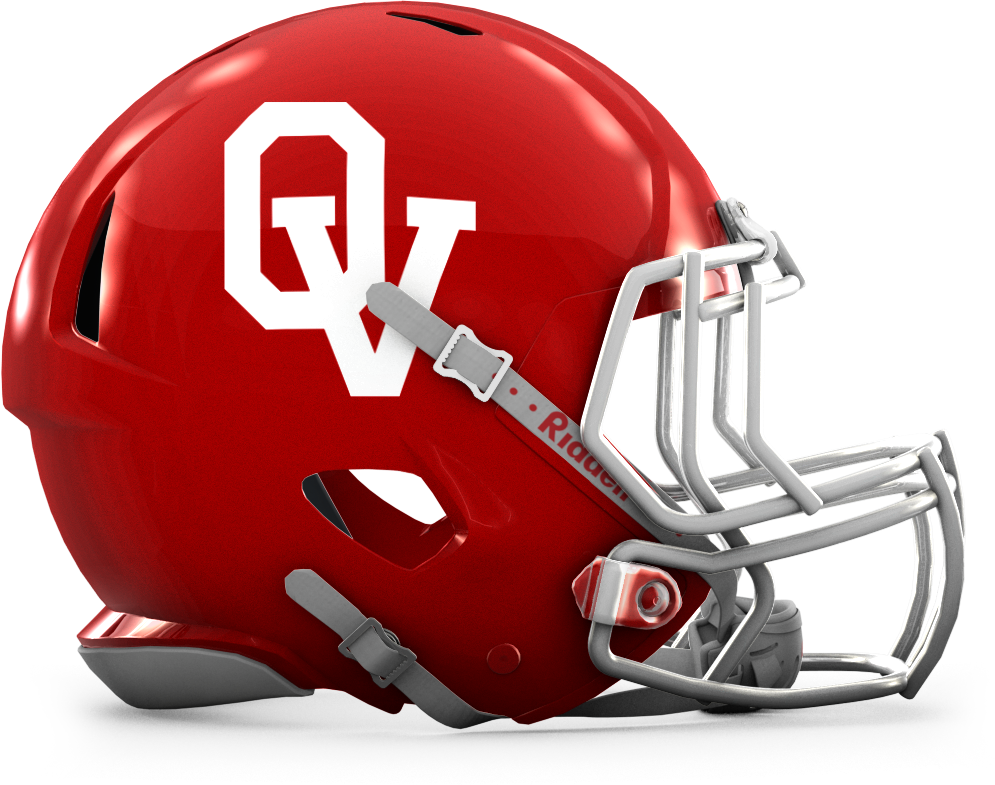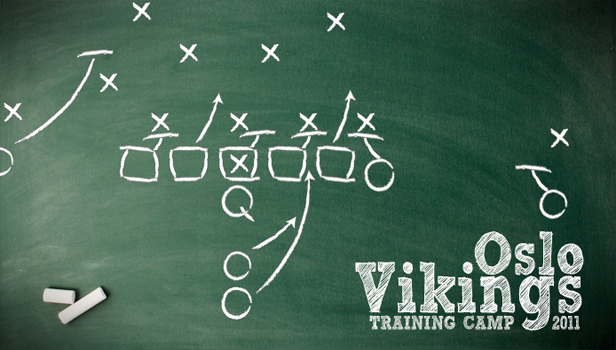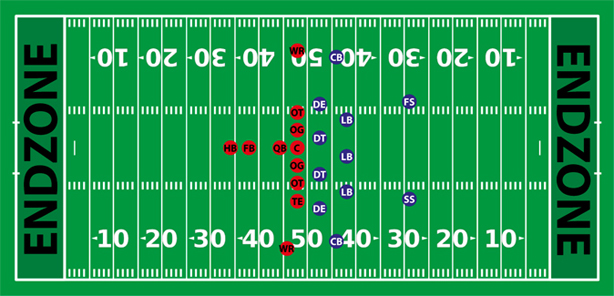 OSLO VIKINGS AFC
OSLO VIKINGS AFC

In Europe and Norway the NCAA (College) rules are used with a few adjustments. Even though the game is essentially the same, there are a lot of differences between NCAA and NFL.
The field is 120 yards long and 53 yards wide, and consists of a 100 yard long playfield with a 10 yard endzone in each end. The fieldgoals behind each endzone are 5,6 meters wide and 3 meters from the ground to the horizontal bar. A properly marked field has side to side lines for each 5 yards, but usually only every 10 yard is marked. On the sides there are also shorter lines for each yard. On the field 18 meters from each sideline are the hashmarks, who are also drawn with short lines for each yard. All plays start between the hashmarks.
There is a lot to pay attention to, and a full referee crew consists of 7 people. In EFAF games there are usually 6 or 7 referees, but in second division and at the junior level five are usually used, sometimes even only 4. No game can start without a minimum of 4 referees.
Each team can have up to 11 players on the field for each play. Usually a player belongs to only one squad, either offense, defense or special teams, but in Europe many players play both ways and sometimes even on special teams. In EFAF games the game day roster can not be more than 45 players, but some teams have even larger rosters and only the 45 best get to play. There are no limitations as to how many players can be substituted between each play.

The offensive unit consists of a quarterback (QB), who is the leader and “boss” on the field. He receives his instructions from the coaches and relays them to the team in the huddle. A huddle is when the players group together a bit away from the other team to plan the next play. In front of the quarterback are at least five linemen (OL), they are usually the biggest guys on the field. Their task is to protect the quarterback on pass or clear a path for the running backs. The last five players can vary based on the situation, but usually there are two runningbacks(RB). Where one is a fullback (FB), whose task is to help block for the runner, and a half-back (HB) who usually gets the ball. Then there are two wide receivers (WR), who usually run down the field to catch passes. Last we have the Tight End (TE). A “large” receiver who can run to catch passes or help block together with the offensive linemen. There are rules for how a team can line up. There has to be at least 7 players on the “Line of scrimmage” (LOS). The LOS is an imaginary line running from one sideline to the other through where the ball is placed. Five of the seven players have to wear jerseys with numbers between 50-79 and are not allowed to run down field on pass plays. Then usually two wide receivers are placed on the line. The remaining players line up where the coach decides.
For the defence there are no strict rules deciding where they line up, except they cannot line up in the neutral zone. The neutral zone is the area defined by the line of scrimmage and one ball length down the field. There are many defensive formations, but usually 3 or 4 defensive linemen (DL) line up opposite the offensive linemen. Their task is to stop the run plays or try to sack the quarterback. Behind them are 3 or 4 linebackers (LB). They have to attack the man with the ball. The remaining players are Defensive Backs (DB), usually called Cornerbacks or Safeties. They primarily cover the receivers, but are also the last line of defense against runners.
There are three different ways to score points:
Touchdown: 6 points – Scored by either running the ball into or catching the ball in the opponents endzone. After a touchdown is scored, the scoring team is awarded with a extra point attempt. Usually the team chooses to try to kick the ball between the goalposts of the fieldgoal, but the can try to throw/run the ball once more. Kicking the ball gives 1 extra point, and running/ throwing the ball gives 2.
Fieldgoal: 3 points – Scored by kicking the ball between the goalposts on a regular down. Usually happens on fourth downs when the team does not think it can make it the remaining yards to get either a touchdown or another first down.
Safety: 2 points – Scored by the defense when they stop the ballcarrier in their own endzone.
The game is started with a kickoff where one team kicks the ball to the other, who in turn try to run the ball as far as possible to get a good field position. The receiving team then gets four attempts(downs) to try to advance the ball ten yards either by running or throwing the ball. Only one forward pass is legal. During a pass players from the defending team are allowed to try to catch the ball. If they success it’s called an interception and the defending team gets control of the ball. There are no limitations to how many times the ball can be passed backwards or sideways. The play stops when the ballcarrier touches the ground with something other than hands and feet, runs out of bounds, a forward pass hits the ground or a touchdown is scored. There are no limitation to how many times the ball can be thrown backwards or sideways during a play. The next play starts where the previous one ended. If the attacking team cannot advance the ball ten yards in four downs, the defending team gets the ball. Usually the attacking team will use their fourth attempt on a punt or a fieldgoal kick. A punt is a kick where the attacking team tries to kick the ball as far down the field as possible to give the defending team a bad field position when they take over the ball.
PENALTIES
All penalties are given in a number of yards, 5, 10, 15 or half the distance left to the goal line. Normally the down is played over after the penalties are given out, but some penalties result in a loss of a down. The referees signals penalties by throwing a yellow flag. If the penalties occurs during the play, the play is allowed to complete. The team who did not perform the illegal action is allowed to accept or decline the penalty. Sometimes it might be more advantageous to decline the penalty if the play puts the ball at a better position then the penalty would.
Want to read more? Check out these links: